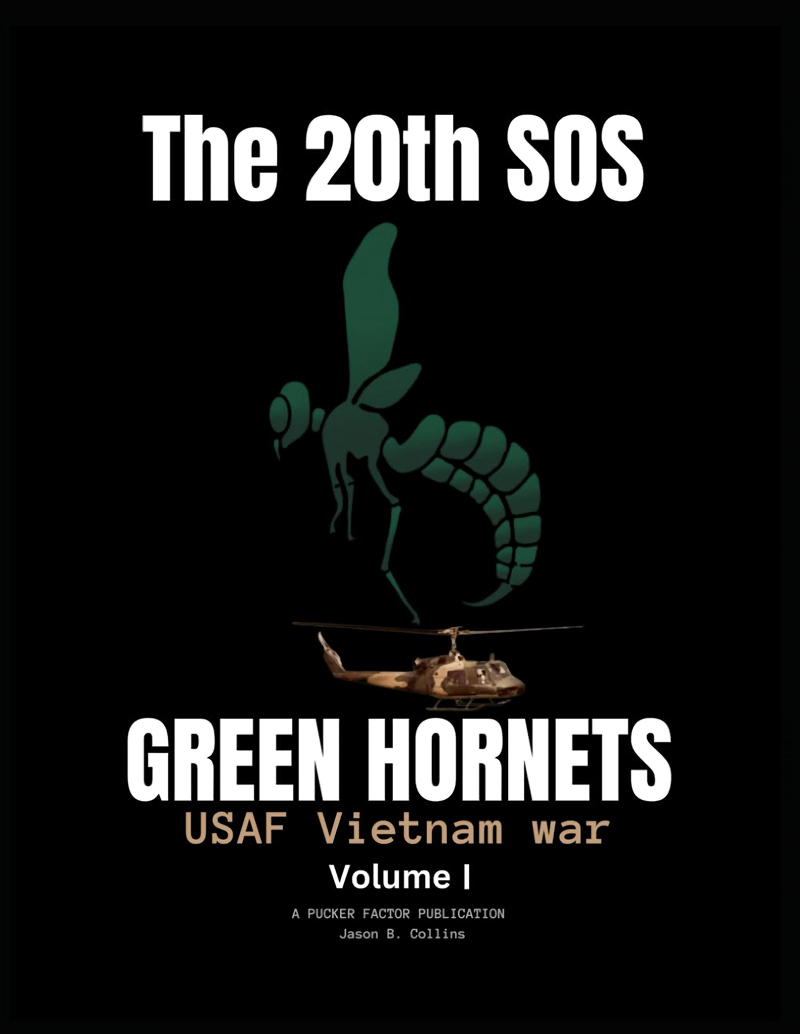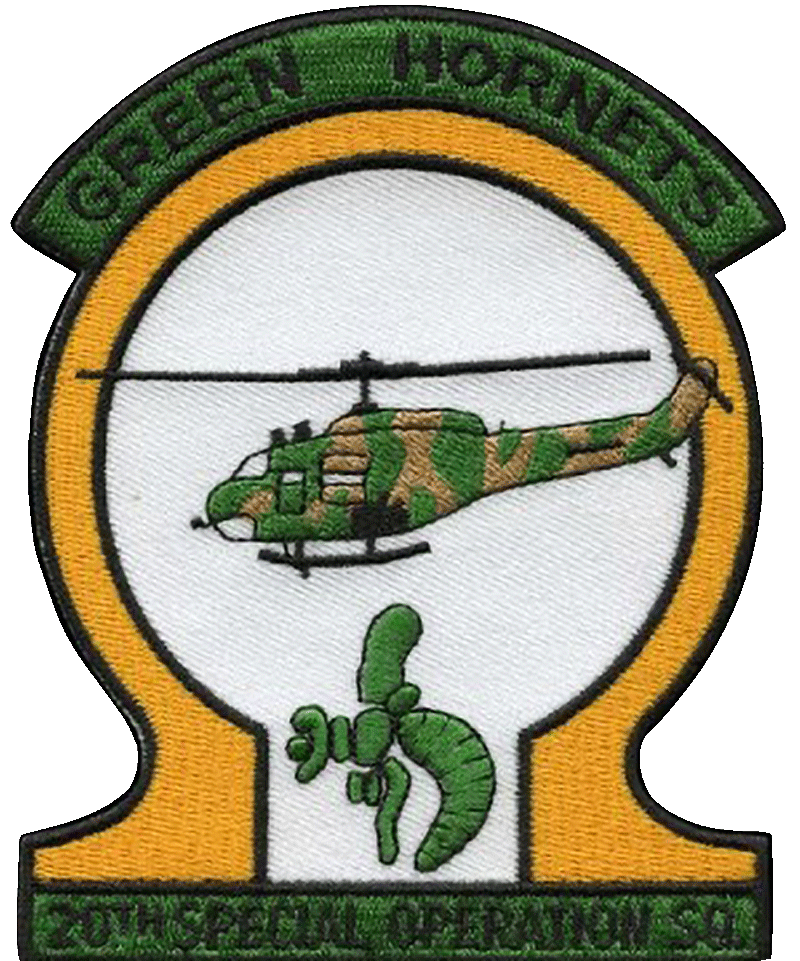PROJECT CHECO
(Contemporary Historical Evaluation of Combat Operations)
South East Asia Reports

By Jason Collins
“Bird Down in Cambodia” is an excerpt from The 20th SOS Green Hornets USAF Vietnam War Volume 1: 20TH SOS GREEN HORNETS in Vietnam by Jim Burns, Ron Winkles, Charles Svoboda, Jason B. Collins; published by Barnes & Noble Press, 12/15/2024; 228 pages.
By July 1967, the unit had 13 UH-1F helicopter deployed at Nha Trang, Tan Son Nhut, and Kontum. From 1 July to 30 September 1967, supporting cross-border operations out of Kontum, the UH-1Fs transported more than 63 tons of cargo and 5,314 passengers, and expended 389,000 rounds of ammunition.
The squadron’s assets were stretched to the limit. Logistics problems, which were due in large part to the conduct of operations remote from the main operating base, compounded the problem of helicopter shortages .
Nevertheless the “Green Hornets” increased the level of operations during the last three months of 1967. The unit performed the following missions in support of MACSOG:
Armed UH-1F:
Infiltration 104
Exfiltration 127
Visual Reconnaissance 66
Army Base Defense 21
Tactical Movement 257
Unarmed UH-1F:
Infiltratio 148
The highlight of the last quarter of 1967 was a change in the location of the Forward Operating Location from Kontum to Ban Me Thuot on 10 December. Ban Me Thuot (BMT), with only a few temporary interruptions, remained the primary FOL of the 20th SOS until its withdrawal from the RVN in early 1972. The probable reason for the move to BMT was to enhance SOG operations into Cambodian territory. The effect of the move on the 20th SOS was alleviation of aircraft shortages and associated logistic problems, since BMT was significantly closer to the main support base at Nha Trang.
“Green Hornet” Operations – 1968 (U)
The “Green Hornets” saw much more direct combat action in early 1968. Reaction to the Communist Tet Offensive accounted for most of the increase by diverting support from the primary mission: SOG cross-border operations. In the first three months of 1968, equipped with 15 UH-1Fs, the unit more than doubled the sortie level of the previous quarter. Armed helicopters fired some 834,000 rounds of ammunition and launched over 2,000 rockets; the first figure represented nearly a three-fold increase, and the second figure a seven-fold increase, over expenditures during the previous quarter.
Although helicopters continually .supported infiltration and exfiltration missions, they frequently supported ground elements in a conventional air assault role. Extracts from the 20th Helicopter Squadron Historical Report describe this type of support:
“The gunships were first scrambled before dawn on 30 January. They fired on suspected mortar concentrations. Later that day two gunships drove VC [Viet Cong] and NVA troops from a stream of refugees and killed six of the enemy as confirmed by FAC’s. Before the day was over, the gunships took part in an assault on an estimated two companies of NVA, dropping, 28 more of the enemy according to FAC’s…At 0330 hours on 2 February 1968, a gunship element was launched to attack observed enemy mortar positions. An enemy position was observed firing and was immediately attacked and destroyed by the gunships. A few minutes later, the flight was advised that an ARVN compound was under heavy attack 2 miles west of Ban Me Thuot. …The gunships put their initial fire at 50 meters inside the perimeter and on succeeding passes worked outward to drive the enemy outside the compound…”
During the spring of 1968, the 20th Helicopter Squadron received eight additional UH-1F helicopters, enabling another surge in operations. To accommodate the new aircraft and aircrews, the unit formed another flight, with the helicopters concentrated at Ban Me Thuot. Normally ten aircraft were situated there at any one time: four gunships, four troop carrier helicopters (commonly called “slicks”), and two spare helicopters (one gunship and one slick).
Support to Daniel Boone operations, compared to other mission, attenuated further during the spring. The 20th Helicopter Squadron rendered support to Daniel Boone operations on only nine days during a three-month period. The unit participated mostly in fire suppression missions, but did perform many insertions and extractions inside the RVN.
From 1 July through 30 September 1968, the newly-designated 20th SOS was able to increase its support to MACSOG so that it represented approximately half of the squadron’s total effort. It retained ten aircraft at Ban Me Thuot but transferred four aircraft to the Udorn detachment. Both in-country and out-country infiltration and exfiltration missions encountered greater enemy resistance. The number of emergency extractions jumped notably. Aircraft damages and crewmember injuries rose proportionately: forty hits from enemy groundfire were sustained, and five crewmembers were wounded.
The following account of an emergency extraction alludes to the hazards of such an operation and underscores the requirements for aircrew courage, flight proficiency, and coordination between ground and airborne forces:
“On 2 September, the UH-1F’s were launched on an emergency extraction of a Long Range Reconnaissance patrol… When the forward air controller arrived, he located their [ground team’s] position and directed them eastward, toward a landing zone. After cresting a hill and starting down slope, the team made contact with hostile forces in a trench and bunker complex.
After exchanging fire with the enemy, the team retreated to the west [UH-1F] crews arrived and protected the team with mini-gun and rocket fire. The FAC directed the team toward a bomb crater approximately 75 yards north; the team met hostile fire after moving approximately 35 yards and had to retreat to their previous position. The gunships continued to deliver ordnance on known enemy positions and were drawing automatic weapons fire from the north, east, and south of the team. The two gunships were getting low on fuel and, prior to being relieved by guns 3 and 4, they continued to suppress the fire in the bomb crater area. The FAC directed the team into the bomb crater… [A slick] crew made a descent to come in at tree top level, and to a hover above the bomb crater. The crater was too small to permit landing, so a rope ladder pickup was made. As the team climbed the rope ladder, Gunships 3 and 4 made repeated mini-gun passes overhead to suppress the automatic weapons fire… During the last five minutes of the pickup, the FAC received fire from heavy automatic weapons to the south. Immediately after the slick departed the landing zone, several hostile troops were spotted in the bomb crater that was used for extraction of the team.”
In the ensuing months of 1968 the “Green Hornets” resumed full-scaIe support to MACSOG. During this period the unit lost two aircraft. On 26 November, one gunship was downed by enemy groundfire during an emergency extraction operation. The next day, a slick registered the second loss when it crashed during an infiltration mission. These losses portended an attrition problem which emerged in 1969 and severely jeopardized the Air Force SAW helicopter role.
The 20th SOS Crisis in 1969 and 1970 (U)
In early 1969 the 20th SOS began experiencing a series of helicopter losses from hostile causes and maintenance malfunctions. The problem became acute in the summer when a rash of engine failures resulted in numerous losses and caused a low operationally ready rate in the remaining force.

MACV SOG Green Hornets 20th SOS UH-1 Tactical Operations
Click on the video image below to visit Jason Collins YouTube channel “MACV-SOG: Interviews with Warriors” for this episode with USAF film footage explaining about the Twin engine UH-1F.
Purchase The 20th SOS Green Hornets USAF in Vietnam, available in hard and soft bound, through Barnes & Noble. This is only volume #1, #2 is the process of being created.
Leave A Comment